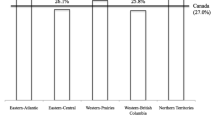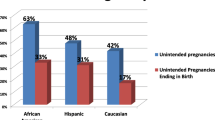Abstract
Objectives: While much attention has been focused on unintended pregnancy in disadvantaged populations, few studies have focused on women in lower risk groups. This study, conducted in a national managed care organization, reports the prevalence of unintended pregnancy resulting in live births and examines associated factors. Methods: Women ages 18–49 who delivered a live infant during a 6-month interval were eligible for the study. Telephone surveys were conducted after delivery. We report the rate of unintended pregnancy resulting in a live birth, and describe its association with sociodemographic and pregnancy-related factors, partner's intention status, and contraceptive use. Results: Of 1173 births, 29% were unintended. Women who reported that the partner did not want the pregnancy were 7.4 times more likely than women whose partner wanted the pregnancy to regard the pregnancy as unintended. Only 40% of the women with an unintended birth used birth control and 64% of those used less effective methods such as condoms and diaphragms. Conclusions: In a population where the majority of women were married, educated, and with incomes over $40,000, almost 1/3 of the births resulted from unintended pregnancies. Future research is needed to help us better understand contradictions in pregnancy intention and contraceptive behavior. Comprehensive efforts are needed to promote consistent and correct use of contraception by women at risk for unintended pregnancy, and to involve male partners in family planning.
Similar content being viewed by others
REFERENCES
Kost K, Landry DJ, Darroch JE. Predicting maternal behaviors during pregnancy: Does intention status matter? Fam Plann Perspect 1998;30:79–88.
Roberts RO, Yawn BP, Wickes SL, Field CS, Garretson M, Jacobsen SJ. Barriers to prenatal care: Factors associated with late initiation of care in a middle-class midwestern community. J Fam Pract 1998;47:53–61.
Delgado-Rodriguez M, Gomez-Olmedo M, Bueno-Cavanillas A, Galvez-Vargas R. Unplanned pregnancy as a major determinant in inadequate use of prenatal care. Prev Med 1997;26:834–8.
Joyce T, Kaestner R, Korenman S. The stability of pregnancy intentions and pregnancy-related maternal behaviors. Matern Child Health J 2000;4:171–8.
Hellerstedt WL, Pirie PL, Lando HA, Curry SJ, McBride CM, Grothaus LC, Nelson JC. Differences in preconceptional and prenatal behaviors in women with intended and unintended pregnancies. Am J Public Health 1998;88:663–6.
Dye TD, Wojtowycz MA, Aubry RH, Quade J, Kilburn H. Unintended pregnancy and breast-feeding behavior. Am J Public Health 1997;87:1709–11.
Kost K, Landry DJ, Darroch JE. The effects of pregnancy planning status on birth outcomes and infant care. Fam Plann Perspect 1998;30:223–30.
Brown SS, Eisenberg L, editors. The best intentions: Unintended pregnancy and the well-being of children and families. Washington, DC: National Academy Press, 1995.
Zuravin SJ. Unplanned childbearing and family size: Their relationship to child neglect and abuse. Fam Plann Perspe 1991;23:155–61.
Orr ST, Miller CA. Unintended pregnancy and the psychosocial well-being of pregnant women. Womens Health Issues 1997;7:38–46.
Abma JC, Chandra A, Mosher WD, Peterson LS, Piccinino LJ. Fertility, family planning, and women's health: New data from the 1995 National Survey of Family Growth. Vital Health Stat 1997;23(19):1–114. National Center for Health Statistics.
Henshaw SK. Unintended pregnancy in the United States. Fam Plann Perspect 1998;30:24–9, 46.
Fischer RC, Stanford JB, Jameson P, DeWitt MJ. Exploring the concepts of intended, planned, and wanted pregnancy. J Fam Pract 1999;48:117–22.
Stanford JB, Hobbs R, Jameson P, DeWitt MJ, Fischer RC. Defining dimensions of pregnancy intendedness. Matern Child Health J 2000;4:183–9.
Fu H, Darroch JE, Haas T, Ranjit N. Contraceptive failure rates: New estimates from the 1995 National Survey of Family Growth. Fam Plann Perspect 1999;31:56–63.
Jones EF, Forrest JD. Contraceptive failure rates based on the 1988 NSFG. Fam Plann Perspect 1992;24:12–9.
Rosenfeld JA, Everett KD. Factors related to planned and unplanned pregnancies. J Fam Pract 199;43:161–6.
Green DC, Koplan JP, Cutler CM. Prenatal care in the first trimester: Misleading findings from HEDIS. Int J Qual Health Care 1999;11:465–73.
Sanderson M, Scott C, Gonzalez JF. 1988 National maternal and infant health survey: Methods and response characteristics. Vital Health Stat 1998;2(125):1–39. National Center for Health Statistics.
Zhang J, Yu KF. What's the relative risk? A method of correcting the odds ratio in cohort studies of common outcomes. JAMA 1998;280:1690–1.
Kost K, Forrest JD. Intention status of U.S. births in 1988: Differences by mothers' socioeconomic and demographic characteristics. Fam Plann Perspect 1995;27:11–7.
Colley Gilbert B, Brantley MD, Larson MK. Family planning practices and pregnancy intention, 1997. Atlanta, GA: Division of Reproductive Health, National Center for Chronic Disease Prevention and Health Promotion, Centers for Disease Control and Prevention, 2000.
Moos MK, Petersen R, Meadows K, Melvin CL, Spitz AM. Pregnant women's perspective on intendedness of pregnancy. Womens Health Issues 1997;7:385–92.
Petersen R, Moos MK. Defining and measuring unintended pregnancy: Issues and concerns. Womens Health Issues 1997;7:234–40.
Kaufmann RB, Morris L, Spitz AM. Comparison of two question sequences for assessing pregnancy intentions. Am J Epidemiol 1997;145:810–6.
Trussell J, Vaughan B, Stanford J. Are all contraceptive failures unintended pregnancies? Evidence from the 1995 National Survey of Family Growth. Fam Plann Perspect 1999;31:246–7, 260.
Klerman LV. The intendedness of pregnancy: A concept in transition. Matern Child Health J 2000;4:155–62.
Sable MR, Libbus MK. Pregnancy intention and pregnancy happiness: Are they different? Matern Child Health J 2000;4:191–6.
Piccinino L, Peterson LS. Ambivalent attitudes and unintended pregnancy. In: Severy LJ, Miller WB, editors. Advances in population: psychosocial perspectives, Vol 3. London: Jessica Kingsley, 1999:227–49.
Poole VL, Flowers JS, Goldenberg RL, Cliver SP, McNeal S. Changes in intendedness during pregnancy in a high-risk multiparous population. Matern Child Health J 2000;4:179–82.
Luker KC. A reminder that human behavior frequently refuses to conform to models created by researchers. Fam Plann Perspect 1999;31:248–9.
Sable MR. Pregnancy intentions may not be a useful measure for research on maternal and child health outcomes. Fam Plann Perspect 1999;31:249–50.
Bachrach CA, Newcomer S. Intended pregnancies and unintended pregnancies: Distinct categories or opposite ends of a continuum? Fam Plann Perspect 1999;31:251–2.
Author information
Authors and Affiliations
Rights and permissions
About this article
Cite this article
Green, D.C., Gazmararian, J.A., Mahoney, L.D. et al. Unintended Pregnancy in a Commercially Insured Population. Matern Child Health J 6, 181–187 (2002). https://doi.org/10.1023/A:1019778129435
Issue Date:
DOI: https://doi.org/10.1023/A:1019778129435




